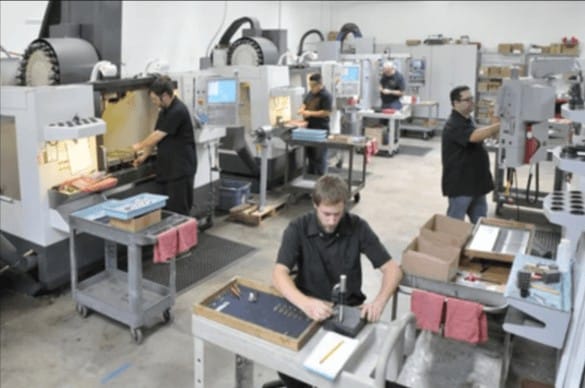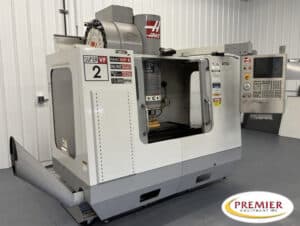Manufacturing shops and operations are always looking for ways to maximize efficiency and productivity as these directly impact the resources and expenses of a company. While manual labor is hard to get away from altogether, bringing in advanced equipment can help achieve better quality results more quickly. Investing in a used CNC machine can help your shop turn out high-quality parts more frequently, improving the company’s bottom line. However, the whole shop needs to run efficiently if you want to have a greater impact on your shop’s success.
How To Define Machine-Shop Efficiency
Efficiency is a term that generally describes how quickly products can be turned out, but the true definition is more specific within the context of a machine-shop. It refers to the use of resources to release a valuable product while minimizing waste in both materials and labor. Considerations include what percentage of raw materials were scrapped due to mishandling or defect or what was the comparison of labor hours to the final value of the product. The entire process must be carefully calculated to ensure maximum value and minimal waste.
The Factors Affecting Machine-Shop Efficiency
The key benefits of CNC machines include higher production capabilities, reduced manual labor and fewer tooling errors. These benefits are answers to the common factors impacting productivity within a machine shop. Here are a few of the challenges with efficiency:
- Timeline for planning: The fabrication process first starts with a planning phase. No work can be completed in the manufacturing plant so long as technical and production planning hasn’t been completed. Poor planning doesn’t allocate resources wisely and interrupts workflow.
- Human error: CNC machines don’t run themselves, and poor man-to-machine rations or underdeveloped operator skills can make it difficult for complex tasks to be completed according to the workflow timeline. Maximizing manpower includes defining what the optimal man-to-machines ratio should be in order to avoid downtime on machines or excessive labor hours for unneeded operators.
- Inventory: Resources are crucial to keeping workflow alive, but poor inventory management can leave machines out of work if stock delays or sudden stock offs occur. Not only will raw materials cause machines to stop running, but failing to keep an inventory of replacement parts or cutting tools will also lead to wasted production potential.
- Tooling capabilities: In addition to the raw materials, the tools and CNC machines are the most important resources in a shop. They are primary assets with a direct impact on production and revenue. They are a financial responsibility that can make or break a company. Used CNC machines that aren’t kept maintenance or improper operations can cause the equipment to fail much sooner than expected, leading to lost productivity and greater expense with replacement or repair.
Helpful Ways To Maximize your CNC Machine Shop
Past shortcomings should be a motivation to alter course, and the machine shop that can evolve and continuously improve will raise productivity. These are some industry tips for making your operations better.
- Use the 5S Mindset
Taken from a Japanese lean manufacturing strategy, the five “s” components are:
- Sort
- Set in order
- Shine
- Standardize
- Sustain
The goal is to reduce waste while maximizing overall productivity. It takes small steps to start, but these have a great impact. Start by organizing the shop floor to support the workflow. Create standard locations for the tooling items, define spaces for workbenches and set up strategic locations for other frequently accessed items. This reduces unnecessary travel and motion around the shop floor, which is unproductive and amounts to incredible amounts of time wasted.
You should also take time to map out your production process. By comprehensively evaluating the entire production line for the shop and your operations, you can see where activities are redundant or add no value to the process. Whatever isn’t necessary detracts from the resources that you are working to conserve and maximize. This analysis and systematic rearrangement of the shop (either physically or with processes) is called value-stream mapping.
- Invest in Quality Equipment
Whether you are trying to function with a used CNC machine or you have a brand new lathe, the quality of the tools and the level of maintenance you keep will impact productivity and results. Spend the money to invest in high-performance cutting tools that will last and turn out excellent reliable products. High-performance tools reduce waste, as the tooling is more accurate. Optimizing your CNC machines will also improve productivity, though it takes the proper tools and operator administration to ensure cycle time is minimal.
- Develop a Growth Mindset
These areas are just small steps toward the greater goal of sustainable, increased productivity. While much of the actual productivity has to do with operator skill and equipment maintenance and programming, a growth mindset that will continually look for ways to refine dated or ineffective processes creates long-term excellence in operations.
Your efficiency depends on your ability to recognize what works and separate those processes from what doesn’t. Commit to your workflow and continue looking for opportunities to improve. Contact us today to learn more about buying a used CNC machine today.



